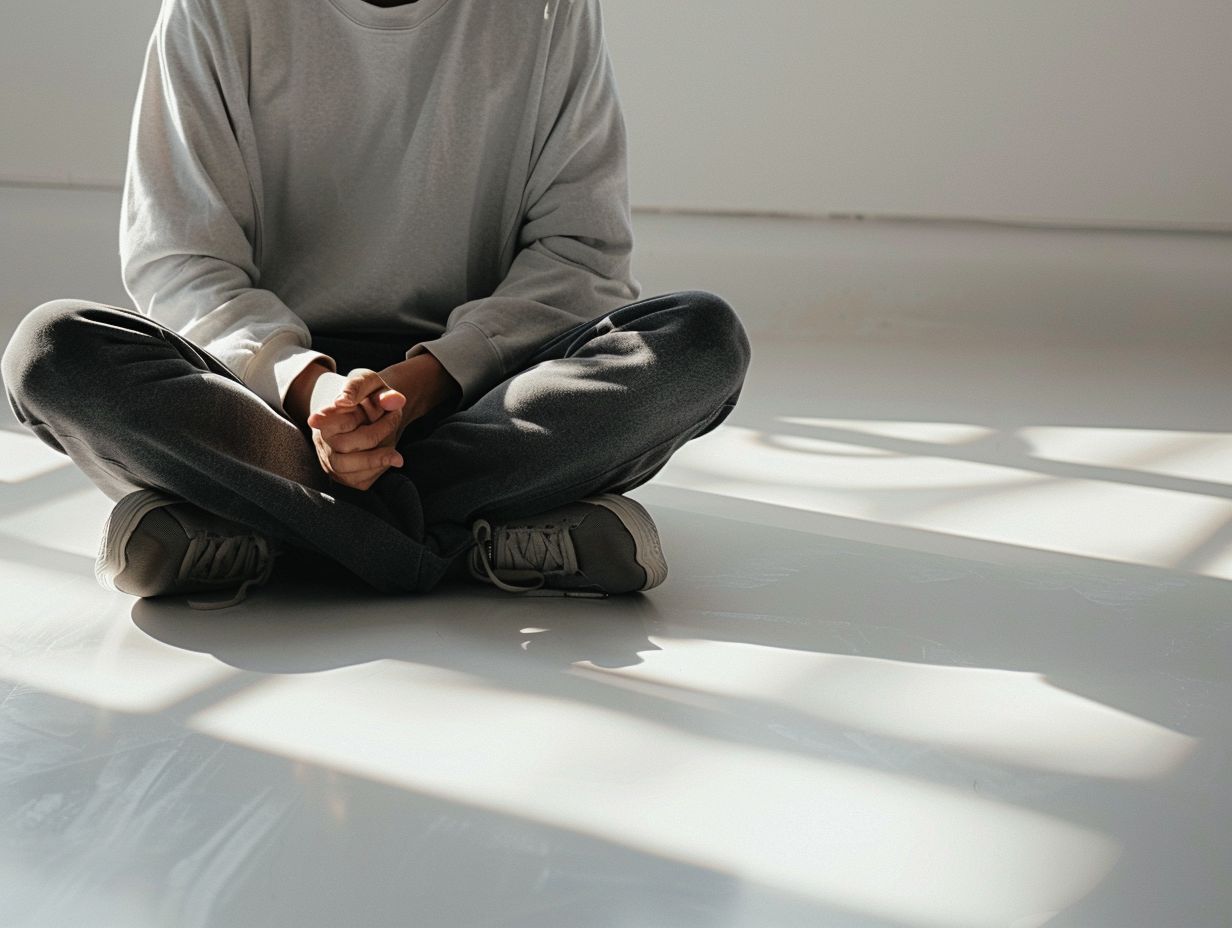Have you ever wondered about the effects of sitting cross-legged on your knees? Let’s dive into the risks and potential benefits of this sitting position, talk about other sitting options and knee-strengthening exercises, and share some tips on how to ease knee pain while sitting and keep your posture in check.
If you’re aiming to upgrade your sitting routine and take care of your knees, stick around to find out more!
What Is Sitting Indian Style?

When you sit Indian style, also known as cross-legged, you’re basically plopping down on the floor with both legs crossed in front of you. It’s a position that’s been around for ages and is linked to various cultures.
In lots of Asian countries, sitting cross-legged is seen as a sign of respect and deference to elders or during religious rituals. It’s a pose that helps you stay mindful and focused, often used during meditation and yoga to find that inner peace and balance.
Some folks love sitting Indian style because it feels cozy and rooted, while others might feel a bit achy, especially in the hips and lower back. Sitting this way comes with perks like better posture, more flexibility, and improved digestion. But sitting like this for too long can make your knees and hips feel stiff and strained.
How Does Sitting Indian Style Affect The Knees?
When you sit cross-legged, it can have both good and bad effects on your knees. Doing this frequently can help increase your hip rotation flexibility, but it might also cause discomfort in your knees and possible joint pain.
As time goes on, sitting in this position can put too much pressure on your knees, affecting your joint health and alignment. The way your hips rotate outward in this position can make your knees bend at an odd angle, which could lead to issues like misaligned kneecaps or straining your ligaments.
Sitting cross-legged for a long time without breaks can make these problems even worse. To ease knee discomfort, try adding some regular stretching exercises to your routine. This can help improve flexibility and strengthen the muscles around your knees for better support.
What Are The Risks Of Sitting Indian Style?
Regarding sitting cross-legged, you should be aware of the risks involved, especially when it comes to your knees and overall joint health. Prolonged sitting in this position can cause discomfort that might lead to joint pain and impact your posture and flexibility.
Sitting cross-legged can put more pressure on your knee joint, potentially causing issues like reduced range of motion, stiffness, and even injuries over time. Additionally, not having support for your lower back while sitting cross-legged can strain your lumbar spine, resulting in discomfort and possible complications.
To lower these risks, try incorporating stretches to enhance hip and knee flexibility, changing positions during long periods of sitting, and using supportive cushions or props under your knees to reduce strain on your joints and promote better posture.
What Are The Potential Benefits Of Sitting Indian Style?
Despite the risks, sitting cross-legged offers you some potential benefits that can positively impact your flexibility and posture. This traditional sitting position can help improve your hip rotation and encourage you to have a more conscious posture.
Sitting in this position can assist you in strengthening the muscles around your hips, lower back, and core, which are crucial for maintaining good posture and preventing discomfort. By making this position a regular part of your routine, you may notice increased body awareness and enhanced flexibility. This can make it easier for you to participate in activities that require bending, twisting, or balancing.
These benefits go beyond just physical health. Improved posture and flexibility can have a positive impact on your mental well-being and overall quality of life. So, next time you settle in for a seated session, consider giving the cross-legged position a try for its potential advantages.
What Are Some Alternatives To Sitting Indian Style?

If sitting cross-legged isn’t your thing or it’s causing you discomfort, there are a bunch of other options you can try out to find a better sitting position that works for you and feels comfortable for your body and preferences.
One idea is to give a chair with good ergonomic support a shot. This can help you keep the right posture and reduce any strain on your back and joints. Sitting on a cushion might offer some extra padding and support, easing the pressure on your knees. Experimenting with different sitting positions, like sitting cross-legged or stretching your legs out, could also help spread your weight more evenly.
The key is to find a position that not only feels good but also helps support your overall health and well-being.
What Are Some Other Sitting Positions?
Aside from sitting cross-legged, there are plenty of other sitting positions you can test out to ease discomfort and improve your posture. These alternative sitting positions are designed to suit various body types and preferences, giving you a variety of choices for a healthier sitting experience.
- One popular alternative sitting position is the kneeling chair. This chair encourages a more upright posture by positioning your hips forward and your back straight. It’s great for reducing lower back pain and improving spinal alignment.
- Another option to consider is the standing desk. With this setup, you can switch between sitting and standing, reducing the risks of being sedentary and promoting better circulation.
- And if you prefer a more laid-back position, the reclined chair might be your best bet. It provides back support and can help relieve pressure on your spine, making those long sitting sessions much more comfortable.
What Are Some Exercises To Strengthen The Knees?
To strengthen your knees and ease joint pain, you can benefit from adding specific exercises to your routine. These exercises focus on the muscles surrounding your knees, improving stability and flexibility in the joint.
For instance, a great exercise to try is the quad set. Sit with your legs straight and tighten the muscles on the top of your thigh, holding for a few seconds before releasing. You can also incorporate leg raises while lying down to strengthen the quadriceps, an important muscle group that supports your knees. Stretching exercises like hamstring stretches and calf stretches are also crucial for maintaining knee flexibility and reducing stiffness. Mixing up these exercises ensures a well-rounded approach to keeping your knees healthy.
How Can You Reduce The Risk Of Knee Pain While Sitting?
To reduce the risk of knee pain while sitting, especially in positions like Indian style, you should focus on improving your posture, adding movement, and taking care of your knee health. By making some simple changes and being mindful of your choices, you can ease discomfort and encourage better knee alignment.
Make sure your chair is at the right height so that your feet comfortably touch the floor and your knees form a 90-degree angle. It’s a small adjustment that can make a big difference in supporting your knees while you sit.
Try to take short movement breaks every 30 minutes to prevent stiffness and boost circulation in your knees. And don’t forget about some subtle knee-strengthening exercises like leg lifts and calf raises that you can do while seated. These exercises can help strengthen the muscles around your knee joint.
Consider setting up your sitting area with ergonomic furniture and cushions to reduce stress on your knees even further. By creating a supportive environment, you can make sitting more comfortable and keep your knees happy.
What Are Some Tips For Proper Sitting Posture?

Maintaining proper sitting posture is key to reducing discomfort and promoting overall health. Whether you’re sitting Indian style or in another position, there are some key tips you can follow to align your spine, support your back, and avoid muscle strain.
Make sure your feet are flat on the floor and your knees are at a 90-degree angle to keep your spine in a natural, neutral position. Using a small cushion or lumbar support behind your lower back can give you extra support and maintain the natural curve of your spine. Keep your shoulders relaxed and resist slouching to prevent unnecessary strain on your neck and shoulders.
By making these mindful adjustments, you can significantly improve your sitting experience and enhance your overall well-being.
How Can You Incorporate Movement Into Your Sitting Routine?
To combat the negative effects of sitting for long periods, it’s important for you to incorporate movement into your routine. Doing simple exercises, stretches, and taking occasional breaks can help improve circulation, increase flexibility, and prevent muscle fatigue.
A great way to add movement is by doing desk stretches as part of your daily routine. These stretches can be easily done at your desk, helping to release muscle tension and keep you flexible.
Another effective strategy is to take short walks during breaks or lunchtime. This breaks up those long sitting sessions and gives you a quick burst of physical activity. Just remember, making movement and flexibility a priority throughout your day can really boost your overall well-being.
When Should You See A Doctor For Knee Pain?
If you’re dealing with persistent knee pain, especially after sitting cross-legged or doing activities that make it worse, it’s a good idea to see a doctor for a proper evaluation. Getting medical advice can help pinpoint any underlying issues, come up with a treatment plan, and stop things from getting worse.
Healthcare pros, like orthopedic specialists or physical therapists, know their stuff when it comes to knee troubles. If your knee pain sticks around for more than a couple of days, or if you notice swelling, instability, redness, or warmth in the joint, or if you’ve had a past injury, it’s a good call to get medical help ASAP.
A healthcare provider can do a thorough check-up, order tests like X-rays or MRIs, and suggest the right fixes like physical therapy, meds, injections, or even surgery to tackle the real cause of your knee woes.
Frequently Asked Questions
Is sitting indian style bad for your knees?

It can be, especially if you have preexisting knee problems or are sitting in the position for extended periods of time.
What are the potential risks of sitting indian style for your knees?
Sitting in this position can put excessive pressure on the knee joints and potentially lead to discomfort, pain, or even injury.
Can sitting indian style cause knee pain?
Yes, sitting in this position can cause knee pain, especially if you are not used to it or do not have the flexibility to sit comfortably in this position.
Are there any benefits to sitting indian style?
While it is a commonly used sitting position, there are no significant health benefits to sitting indian style. It is more of a cultural habit than a beneficial posture.
How can I prevent knee pain while sitting indian style?
You can avoid knee pain by taking frequent breaks and stretching your legs, avoiding sitting in the position for extended periods of time, and maintaining good posture while sitting.
Is there a better sitting position for my knees?
Yes, there are many alternative sitting positions that can be more comfortable and less strenuous on your knees, such as sitting with your feet flat on the ground or using a supportive chair with proper back and knee support.

